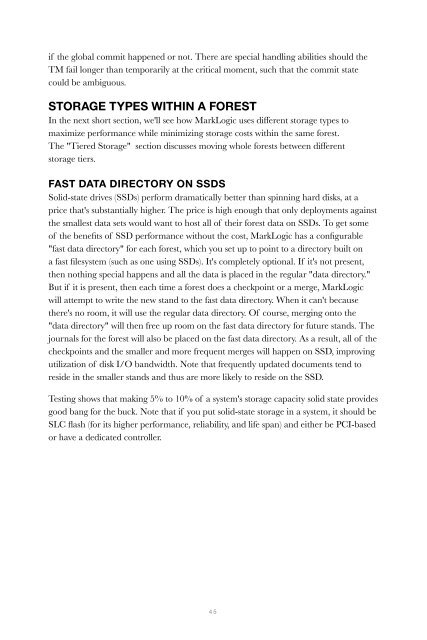You also want an ePaper? Increase the reach of your titles
YUMPU automatically turns print PDFs into web optimized ePapers that Google loves.
if the global commit happened or not. There are special handling abilities should the<br />
TM fail longer than temporarily at the critical moment, such that the commit state<br />
could be ambiguous.<br />
STORAGE TYPES WITHIN A FOREST<br />
In the next short section, we'll see how MarkLogic uses different storage types to<br />
maximize performance while minimizing storage costs within the same forest.<br />
The "Tiered Storage" section discusses moving whole forests between different<br />
storage tiers.<br />
FAST DATA DIRECTORY ON SSDS<br />
Solid-state drives (SSDs) perform dramatically better than spinning hard disks, at a<br />
price that's substantially higher. The price is high enough that only deployments against<br />
the smallest data sets would want to host all of their forest data on SSDs. To get some<br />
of the benefits of SSD performance without the cost, MarkLogic has a configurable<br />
"fast data directory" for each forest, which you set up to point to a directory built on<br />
a fast filesystem (such as one using SSDs). It's completely optional. If it's not present,<br />
then nothing special happens and all the data is placed in the regular "data directory."<br />
But if it is present, then each time a forest does a checkpoint or a merge, MarkLogic<br />
will attempt to write the new stand to the fast data directory. When it can't because<br />
there's no room, it will use the regular data directory. Of course, merging onto the<br />
"data directory" will then free up room on the fast data directory for future stands. The<br />
journals for the forest will also be placed on the fast data directory. As a result, all of the<br />
checkpoints and the smaller and more frequent merges will happen on SSD, improving<br />
utilization of disk I/O bandwidth. Note that frequently updated documents tend to<br />
reside in the smaller stands and thus are more likely to reside on the SSD.<br />
Testing shows that making 5% to 10% of a system's storage capacity solid state provides<br />
good bang for the buck. Note that if you put solid-state storage in a system, it should be<br />
SLC flash (for its higher performance, reliability, and life span) and either be PCI-based<br />
or have a dedicated controller.<br />
45


